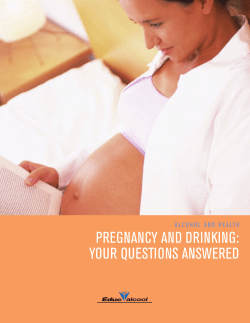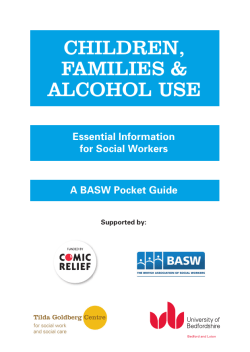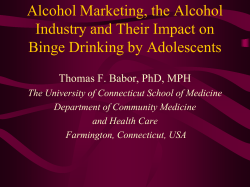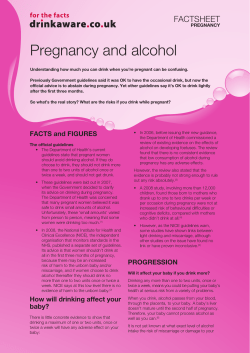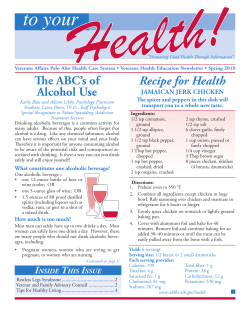
Document 136158
Quick Reference Guide to the Treatment of Alcohol Problems Companion Document to The Guidelines for the Treatment of Alcohol Problems Prepared for the Australian Government Department of Health and Ageing by Paul Haber, Nicholas Lintzeris, Elizabeth Proude and Olga Lopatko Quick Reference Guide to the Treatment of Alcohol Problems ASSESSMENT & TREATMENT PLANNING Screening - quantity-frequency estimates (“how much how often”) Screening aims to identify and then initiate appropriate interventions in individuals drinking above low-risk levels. Conduct in settings where detection is relevant to both the clinician and the drinker, such as primary care, emergency departments, hospital, specialist medical and general counseling settings. Recommended approaches include - structured questionnaires (e.g. AUDIT, available at www.cs.nsw.gov.au/drugahol/drinkless) An abbreviated version, the AUDIT-C, is adequate for identifying high-risk drinkers (score ≥ 5). 1. How often do you have a drink containing alcohol? Never Monthly or less 2-4 times a month 2-3 times a week 4 or more times a week (0) (1) (2) (3) (4) 2. How many drinks containing alcohol do you have on a typical day when you are drinking? 1 or 2 3 or 4 5 or 6 7 to 9 10 or more (0) (1) (2) (3) (4) 3. How often do you have six or more drinks on one occasion? Never Less than monthly Monthly Weekly Daily or almost daily (0) (1) (2) (3) (4) (Score of ≥ 5 indicates further assessment is required) Patients drinking above low-risk levels (see NHMRC recommendations) should be offered a brief intervention. Those experiencing moderate-severe alcohol related Figure 1 problems, including dependence, require more comprehensive assessment and intensive treatment approaches (Figure 1). Screening Quantity-frequency estimates Questionnaires (e.g. AUDIT) Physical examination and Biological markers Drinking within low-risk levels Drinking exceeds low-risk levels Mod-severe alcohol problems or dependence Brief advice and/or other intervention (FLAGS) Comprehensive assessment NO Effective in reducing alcohol use & addressing presenting problem(s)? YES Encourage continued low-risk use 2 Quick Reference Guide to the Treatment of Alcohol Problems Comprehensive assessment Recommended where individuals present with significant alcohol (or other drug)-related problems. May require more than one consultation, and may involve collateral history from relatives, friends, other health or welfare workers. Presentation - Presenting problems - Role of drinking/drug use in presenting problems Alcohol and other drug use - Quantity (in grams alcohol per day), frequency, pattern of drinking and other drug use (tobacco, pharmaceutical and illicit drugs, injecting drug use) - Last use of alcohol and other drugs (time and amount) - Duration of drug and alcohol use - Features of abuse or dependence. Dependence highlighted by inability to control use despite harms from alcohol use, tolerance and withdrawal symptoms. If dependent, assess likely withdrawal severity (best predicted by previous withdrawal episodes) and history of withdrawal complications (seizures, delirium, hallucinations). - Motivation to change pattern of alcohol or other drug use Consequences of alcohol and other drug use - Examination (by suitably trained health professionals) - Mental state (general presentation, cognition, memory, mood, speech, thought, perception, insight ) - Investigations: Consider breath alcohol test, blood tests (LFTs, FBC, U+Es), investigations for specific conditions Overall assessment and management plan - Goals of treatment (abstinence versus reduced drinking, other health concerns) - Risk management plan (harm to self / others, serious physical or mental illness, medico-legal requirements) - Treatment plan (need for brief interventions, controlled drinking strategies, intensive interventions (detox, psychosocial interventions, relapse prevention strategies), management of co-morbidities - Involvement of other health and/or welfare services, family /carers Physical health problems (include liver, gastro-intestinal, trauma, cardiovascular, neurological) Mental health problems (suicide risk, depression, anxiety, psychosis) Social functioning (including relationship, employment, financial, housing, legal) Risks to self/others (violence, driving, child protection, occupational risks, falls) Alcohol dependence A chronic relapsing remitting disorder associated with impaired control over alcohol use in which individuals find it difficult to cut down or stop, despite persistent physical, psychological or social harms. Physiological aspects include tolerance (diminished effect with repeated use), and a withdrawal syndrome following cessation of use. Dependence generally requires more intensive treatment than brief interventions: they may require a withdrawal program (detoxification) to enable them to stop drinking, and ongoing interventions to ‘stay stopped’ (e.g. counselling, pharmacotherapy, self-help programs). Controlled drinking for dependent drinkers: A realistic goal? Many people would like to continue drinking at ‘low levels’, or resume ‘moderate’ drinking soon after withdrawal. Severity of dependence is a key factor when setting goals of controlled drinking or abstinence. Controlled drinking is usually more appropriate with lower levels of dependence, while higher levels of dependence indicate abstinence as the best option. Controlled drinking may be attempted after a period of abstinence of at least 3-6 months for such individuals. Structured counselling programs with the specific goal of ‘controlled drinking’ are available (see www.acar.net.au). 3 Quick Reference Guide to the Treatment of Alcohol Problems Treatment planning Discuss treatment options with the patient (and their families or carers as relevant), identifying - what is involved with each approach, - the likely outcomes (including potential adverse outcomes) of treatment options, - the patient’s particular needs. drinking, abstinence) are achieved. This approach requires ongoing patient review and monitoring. Provide an opportunity to raise questions or concerns. As with any intervention, informed consent is essential. Involving the patient in decision making may also enhance treatment adherence and improve outcomes. People with chronic heavy alcohol use often have a range of medical, psychiatric, and social problems that typically requires involvement of multiple services. This in turn requires close communication between service providers, and case-co-ordination (case management) by a service provider that will ensure the patient receives long term follow-up. A stepped care model is proposed. That is, patients should be offered the least “intensive” intervention appropriate to their presentation. Should the first intervention prove to be insufficient to achieve the agreed treatment goals for the patient, the next level of intensity of treatment should be offered until the desired treatment goals (e.g. low risk Figure 2 Comprehensive assessment Treatment plan to address sPRESENTINGPROBLEMS medical, psychiatric, social needs sCOORDINATESERVICEPROVIDERS Presenting problem(s) Alcohol and other drug use Medical & psychiatric co-morbidity Social circumstances Motivation and treatment goals Low Severity of alcohol problems /dependence Moderate to severe YES Brief intervention Patient requires withdrawal management NO Withdrawal intervention NO Intensive treatment interventions Effective in reducing alcohol use & addressing presenting problems? YES Psychosocial interventions - Motivational interviewing - Relapse prevention strategies - CBT approaches (coping skills training, controlled drinking, couples therapy) Medication (naltrexone, acamprosate, disulfiram) Self-help approaches (AA, Smart Recovery) Residential rehabilitation programs Follow-up and after-care strategies 4 Quick Reference Guide to the Treatment of Alcohol Problems BRIEF INTERVENTIONS Brief interventions provide information and advice aimed at reducing risky alcohol use, and/or mild alcohol-related problems. They are not usually sufficient in individuals who have developed dependence or experiencing more severe alcohol related harms (for whom more intensive treatment is recommended). Brief interventions: - are delivered in one to four sessions, each lasting from 5-10 minutes to 1 hour. - may be opportunistic, offered to individuals identified through screening who have not sought treatment. - FLAGS is a useful acronym that helps identify the ingredients of brief Interventions (see box below). If the patient is still drinking to excess following a brief intervention, more intensive treatment is indicated, and may involve referral to a specialist alcohol and drug service. Brief intervention using FLAGS approach Feedback about the risks associated with continued drinking, based on current drinking patterns, problems and health status. Discuss potential health problems that can arise from risky alcohol use. Listen to the patient’s response. This should spark a discussion of the patient’s consumption level and how it relates to general population consumption. Advice: Give clear Advice about the importance of changing current drinking patterns, in a persuasive but non-judgemental way. Discuss potential benefits of reduced drinking. Goals: Discuss the safe drinking limits and assist the patient to set goals for changing drinking patterns. Instil optimism in the patient that his or her chosen goals can be achieved. Motivation-enhancing techniques can be used to encourage patients to develop, implement and commit to plans to stop drinking. Strategies: Discuss practical strategies to reduce drinking, such as switching to low-alcohol beer, alternating alcohol with non-alcoholic drinks, reducing drink size, eating during drinking sessions. Plan an alternative focus for socialising or unwinding. Identify high-risk situations and practical ways to deal with these. Consider follow-up of the patient. Reinforce the brief intervention by self-help material. Examples can be downloaded at www.alcohol.gov.au. 5 Quick Reference Guide to the Treatment of Alcohol Problems ALCOHOL WITHDRAWAL Individuals who regularly drink large amounts of alcohol (e.g. >80gm daily) may experience a withdrawal syndrome when ceasing or reducing their alcohol use. Alcohol withdrawal can result in severe and life threatening complications (e.g. seizures, delirium) if unsupervised or poorly managed. Withdrawal symptoms generally start within 6 to 24 hours of the last drink, peak over 36 to 72 hours, and usually subside within 5-7 days; although cravings, mood and sleep disturbances may persist for weeks. s Alcohol withdrawal seizures (tonic-clonic) usually occur in 6-48 hrs after last drink s Alcohol withdrawal delirium usually occurs 2-5 days after last drink s Alcohol withdrawal hallucinations can occur at any time during withdrawal Course of alcohol withdrawal Severity of signs and symptoms Seizures Severe withdrawal Mild withdrawal anxiety agitation tremor nausea tachycardia hypertension disturbed sleep raised temperature vomiting extreme agitation disorientation confusion paranoia hyperventilation delirium tremens Mortality up to 40% from infections, fever and fluid loss if untreated; less than 1% with adequate treatment Hallucinations 1 2 3 4 Days Source: NSW Health Detoxification guidelines Assessment History s Alcohol and other drug use: how much, how often, for how long, when last used, features dependence s Previous withdrawal attempts and any complications (seizures, delirium, hallucinations) s Home environment and social supports s Medical and psychiatric conditions Examination s Vital signs (BP, PR, temp, dehydration, level of consciousness), evidence intoxication, withdrawal signs (tremor, anxiety, sweating, tachycardia) s Signs of liver disease, other complications of alcohol use Investigations: breath alcohol, LFTs, FBE, U and Es. Withdrawal setting In most cases alcohol withdrawal can be safely completed in the patient’s home (ambulatory withdrawal) if there are sufficient supports. There are some exceptions to this: Contraindications to ambulatory withdrawal s Severe complications (seizures, delirium, psychosis) in previous (or current) withdrawal attempts 6 s Unstable medical or psychiatric problems (e.g. suicide risk, recent head injury) s Unclear history of current drug and alcohol use Relative contraindications s Unsuitable home environment: drug or alcohol use by others, no suitable supportive adult s Withdrawal from multiple drugs s Repeated failure at ambulatory withdrawal Refer patients unsuitable for ambulatory withdrawal to a residential detox, unless there are severe medical (e.g. recent seizure, delirium) or psychiatric conditions that warrant hospital admission. Management of Ambulatory Alcohol Withdrawal Supportive care s Provide information about alcohol withdrawal to patient and carers s Monitoring and supportive counselling from health worker (e.g. GP, drug and alcohol worker, nurse). Focus on strategies for coping with withdrawal symptoms, maintaining motivation and reassurance. Daily if possible. s 24 hour telephone counselling / crisis telephone service Nutrition s Plenty of fluids (at least 2 litres per day); light diet - avoid heavy meals s Thiamine supplements 300mg per day x 7 days: IM if nutritionally depleted; oral dose if ‘healthy’ Medication s Oral diazepam recommended for moderate to severe withdrawal. Typical ambulatory withdrawal regimen is shown. Adjust dose according to patient’s response, withdrawal severity and other medical conditions Days 1 & 2 Day 3 Day 4 Day 5 10mg QID 10mg TDS 10mg BD 10mg nocte Do not usually continue diazepam beyond 5 days Have contingency plans for any problems, including contact numbers for counselling (e.g., crisis line), doctor, ambulance. s Limit access to diazepam with daily pickup from a pharmacy or clinic, or supervised by a responsible adult s Withhold doses if patient continues to drink or is sedated s Adjunct symptomatic (as required) medications for headache (e.g. paracetamol), nausea and vomiting (e.g. metoclopramide), abdominal cramps (e.g. hyoscine), diarrhoea (e.g. loperamide) s Medications NOT usually recommended for withdrawal include anticonvulsants, chlormethiazole, antipsychotics and antidepressants. Quick Reference Guide to the Treatment of Alcohol Problems INTENSIVE TREATMENT INTERVENTIONS Detoxification alone rarely results in long-term abstinence from alcohol use – and longer term treatment after withdrawal is generally associated with better outcomes. Recommended treatment strategies include: Monitoring and support: Regular monitoring by a health practitioner (alcohol and drug worker, GP, nurse) is important to maintain motivation and assist the patient to follow through with services. Counselling services: Counselling approaches that focus upon relapse prevention strategies can effectively reduce alcohol use, and can be delivered in individual (one to one) or group settings. Relapse prevention approaches are aimed at helping patients to identify situations that in the past have been associated with excessive drinking and to use appropriate cognitive and behavioural strategies to learn how to avoid unnecessary risk, how to deal positively and confidently with inevitable risk, and how to prevent a lapse from becoming a relapse. Many counselling approaches are based upon CBT principles, including coping skills training and behavioural self-management. Some patients may also benefit from counselling for other issues, such as addressing mood or anxiety problems, unresolved grief, post-traumatic stress. Linkages to social and welfare services: Individuals may require social and welfare assistance regarding financial, legal, accommodation, child support, employment problems. Support for families: Family members, friends or carers of heavy drinkers experience a range of emotions in living with, and trying to support drinkers. Many benefit from support and the opportunity to discuss how they are coping. Self-help groups (e.g. AlAnon) and professional services for families and carers are available. Contact http://www.al-anon. org/australia/ Medication: Various medications are effective in reducing alcohol use after withdrawal: Naltrexone: opioid antagonist that reduces cravings for alcohol, reduces number of drinking days and the amount consumed in about 40-60% of patients. Avoid in those requiring opioid analgesia. Dose: 25mg for 2 days, increasing to 50mg once daily. Initiate 3 days after last drink. Acamprosate: works via glutamate pathways to reduce alcohol cravings. Dose: 666mg tds oral. Can initiate 3 days after last drink Disulfiram: alcohol dehydrogenase inhibitor: causes severe reaction (nausea, headache, abdo discomfort) if patient drinks alcohol. Requires motivated patient with dose supervision by carer. Consider written agreement with patient. Discuss with addiction specialist if liver or cardiac disease. Dose: 200mg per day. Initiate > 7 days after alcohol withdrawal, > 48 hrs after last drink Medications should not necessarily be discontinued following a lapse, but review treatment plan. Continue for at least 6 months if effective. Self-help programs. The main approach is the 12-step AA program. AA is a self-help peer-based organisation that aims to assist members achieve and maintain sobriety. Details of local meetings are available at www.aa.org.au. Smart Recovery is another self-help program for patients who are not keen to attend AA. Contact on www. smartrecoveryaustralia.com.au or ADIS. Residential rehabilitation programs (also known as Therapeutic Communities). Long term programs (usually 1 to 12 months) where people live in a community of other substance users, ex-users and professional staff. Programs usually include counselling, employment, education and skills training, life skills training (e.g. budgeting, cooking), group work, relapse prevention, and a ‘re-entry’ phase assisting return to the community. Generally suited for moderate to severely dependent people who require structured social supports. Treatment of psychiatric and physical co-morbidity. Ensure identification and treatment of concomitant conditions. Many medical and mental health problems linked to alcohol use often resolve or improve following drinking cessation, but this can take several weeks (and in some cases months) of abstinence before marked improvement occurs. 7 Quick Reference Guide to the Treatment of Alcohol Problems WORKING WITH THE PERSISTENT ‘PROBLEM’ DRINKER Alcohol dependence is a chronic relapsing condition. Many individuals will continue to drink at excessive levels, experience alcohol related harms, and will not be receptive, or respond to the various treatment approaches aimed at reducing alcohol use. It is crucial for the patients to retain engagement with a health practitioner (e.g. primary care worker, counsellor, social worker), and to maintain an underlying sense of hope for the patient is important. Strategies for working with such individuals are discussed in the table below. STRATEGIES FOR WORKING WITH PERSISTENT PROBLEM DRINKERS 1. Continue to encourage a reduction or cessation of alcohol intake s4HIAMINESUPPLEMENTSTOPREVENTFURTHER CNS and peripheral nerve damage 2. Provide regular feedback regarding the impact of alcohol upon their physical, mental & social health s.UTRITIONALMANAGEMENTFORADVANCED liver disease 3. Minimise the harms from polydrug use, by advising against and offering treatment for other drug problems s&ALLSPREVENTIONSTRATEGIESFORTHOSEWITH cerebellar damage and/or peripheral neuropathy 4. Monitor prescribed and complementary medications to avoid predictable drug/alcohol interactions. Identify and respond to problems of poor medication adherence in heavy drinkers 8. Engage psychosocial supports (‘meals on wheels’, welfare, employment support, community and religious networks, financial or relationship counselling) to reduce personal and family harms 5. Use strategies to enhance patient engagement, 9. Empower family and close friends to reduce including approaches to overcome barriers posed availability of alcohol and to encourage further by cognitive disorders, language and cultural engagement with clinicians able to help with issues, or physical disabilities alcohol problems 6. Define and attend to any specific medical 10. Consider any medico-legal or ethical obligations, and psychiatric conditions with relevant services including driving assessment, child protection, that communicate regularly welfare, guardianship and employment issues 7. Consider strategies to minimise the consequences for those in certain trades or professions. of specific medical complications, such as Motivating patients to change drinking patterns Recognise that patient’s motivation to change their drinking patterns is not fixed, and can be influenced by health professionals, families and friends, or changes in circumstances. Motivational interviewing approaches are recommended. Motivational Interviewing is a style of counselling that focuses on helping the individual explore and resolve ambivalence about change. The patient’s own reasons for change are elicited and used to motivate movement towards action and behaviour change. Key principles of motivational interviewing are: 1. Expressing empathy by listening and reflecting your patient’s concerns, thoughts and feelings. 8 2. Developing discrepancy between their drinking behaviour and their other goals (e.g. ‘on the one hand you’re worried about how drinking is affecting your work, yet you’re not sure if you can stop drinking right now.’) 3. Rolling with resistance. If your patient is arguing, defending, or remaining silent, do not argue back. Instead, use active listening and reflection to avoid increasing their resistance. 4. Supporting self-efficacy. Self-efficacy is the person’s confidence in their own ability to achieve their goals. Highlighting even small gains can help (e.g. a patient might not have stopped drinking but may have managed to cut down or have had one or two alcohol free days in the week.) Quick Reference Guide to the Treatment of Alcohol Problems RESOURCES AND CONTACT INFORMATION For information regarding local treatment services and referral options, contact the local Alcohol and Drug Information Service or Drug and Alcohol Specialist Advisory Service. NSW: http://www.nsw.gov.au/package.asp?PID=9538 VIC: http://drugsandalcohol.dhs.vic.gov.au/directline.htm Phone: 1800 023 687 or (02) 9361 8006 Phone: 1800 888 236 QLD: http://www.health.qld.gov.au/atod/ Phone: (07) 3837 5989 or 1800 177 833 SA: Phone: (08) 8363 8618 or 1300 131 340 http://www.dassa.sa.gov.au/site/page.cfm?u=110 WA: www.dao.health.wa.gov.au/tabid/69/Default.aspx NT: Phone: 1800 198 024 or (08) 9442 5000 1800 131 350 or 1800 629 683; Alice Springs (08) 8951 7580; Darwin (08) 8922 8399; Amity House (08) 8944 6565 or 1800 684 372 TAS: (03) 9416 1818 or 1800 811 994 ACT: http://health.act.gov.au/c/health?a=da&did=10038160&pid=1058840628 Phone: (02) 6207 9977 or (02) 6205 4545 Contact details for further help and services Australian National Council on Drugs: Alcoholics Anonymous (AA): Al-Anon (for friends & relatives): SMART Recovery: Controlled Drinking: http://www.ancd.org.au www.aa.org.au http://www.al-anon.org/australia/ www.smartrecoveryaustralia.com.au http://www.acar.net.au/cdcp01.html To take part, phone 1800 006 557 Full treatment guidelines available at NHMRC guidance CIWA website www.alcohol.gov.au http://www.nhmrc.gov.au/publications/synopses/ds10syn.htm http://www.ciwa-ar.com/ Quick Reference Guide to the Treatment of Alcohol Problems ISBN: 1-74186-978-1 Online ISBN: 1-74186-979-X Publications Number: P3-5626 Copyright Statements: Paper-based publications © Commonwealth of Australia 2009 This work is copyright. Apart from any use as permitted under the Copyright Act 1968, no part may be reproduced by any process without prior written permission from the Commonwealth. Requests and inquiries concerning reproduction and rights should be addressed to the Commonwealth Copyright Administration, Attorney-General’s Department, Robert Garran Offices, National Circuit, Barton ACT 2600 or posted at http://www.ag.gov.au/cca Internet sites © Commonwealth of Australia 2009 This work is copyright.You may download, display, print and reproduce this material in unaltered form only (retaining this notice) for your personal, noncommercial use or use within your organisation. Apart from any use as permitted under the Copyright Act 1968, all other rights are reserved. Requests and inquiries concerning reproduction and rights should be addressed to Commonwealth Copyright Administration, Attorney-General’s Department, Robert Garran Offices, National Circuit, Barton ACT 2600 or posted at http://www.ag.gov.au/cca 9
© Copyright 2025




